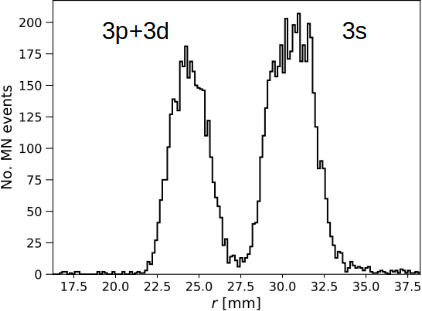State-selective mutual neutralization in DESIREE
The DESIREE facility, with its unique design of two storage rings with a common straight section allows for studies of mutual neutralization (MN) of pairs of oppositely charged atomic or molecular ions. The first such results from DESIREE on Li+ + D- → Li + D was very recently published[1].
Beams of Li+ and D- were produced in separate ion sources and injected into the two rings. Neutral atoms formed in MN reactions in a common section of the two storage rings continue in free flight and impact on a detector recording their positions and the time interval between their impacts. This allows a determination of the distance between the two product atom from individual MN events in all three dimensions when they reach the detector plane. A measured distance distribution is shown in the figure. The distance by which the two atoms separate depends on the kinetic-energy release of the reaction and thus carries information on the quantum states in which the product atoms are formed. In all cases, the hydrogen atom is in its ground state while the two peaks to the right and left in the figure correspond to the lithium being formed in 1s23s2S or in one of the un-resolved 1s23p2P and 1s23d2D levels, respectively.

From these data, we deduce the branching ratio for forming the 3s state, which is of significance for deducing the Li content in stars from astronomical observations. This was the motivation for the experiment, which was carried out in collaboration with Paul Barklem from Uppsala University.
Our results agree with a recent single-pass experiment from Louvain-la-Neuve[2]. In coming investigations, MN will be studied for cold molecular ions available in DESIREE due to the long-time storage capability at cryogenic temperatures[3].
- [1] G. Eklund et al. Phys. Rev. A, 102, 012823 (2020)
- [2] T. Launoy et al. Astrophys. J. 883, 85 (2019)
- [3] H. T. Schmidt et al. Phys. Rev. Lett. 119, 073001 (2017)